- Details
- Hits: 1585
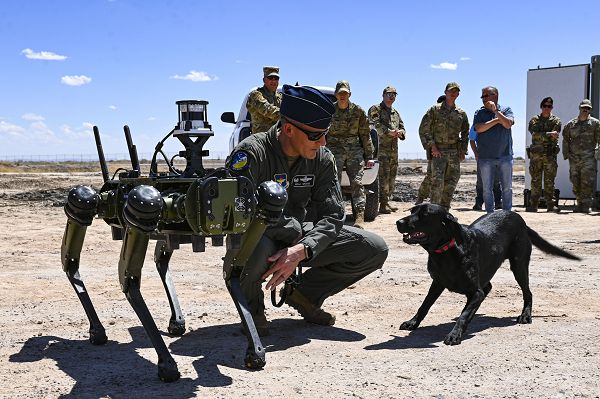
Holloman Air Force Base, New Mexico. (April 17, 2023): In this photo by Airman 1st Class Isaiah Pedrazzini, Col. Justin Spears, 49th Wing commander, introduces his dog, Blue, to a Vision 60 Q-UGV ground robot, a quadrupedal “Dog” capable of maneuvering through rough terrain making it perfect for patrolling Holloman AFB’s arid environment. In all fairness to Blue, the Vision 60 has a lot of built-in advantages over man’s best friend.
The Vision 60 Q-UGV is a mid-sized, high-endurance, agile, and durable all-weather ground robot for use in a broad range of urban and natural environments. The U.S. military has been aggressively deploying these robotic sentries for defense, homeland security, and traditional public safety applications. Unlike a real dog, the Vision 60 can operate at full speed for over three hours and remain on standby for 21 more while still running its onboard computers, sensors, and radio communications.
Using built-in RGB color recognition and depth sensors, the Vision 60 can traverse any terrain that is navigable by humans. This hound uses this “situational awareness” to negotiate obstacles that would have caused previous designs to “freeze resulting in the robot having to end its mission.
- Details
- Hits: 1395
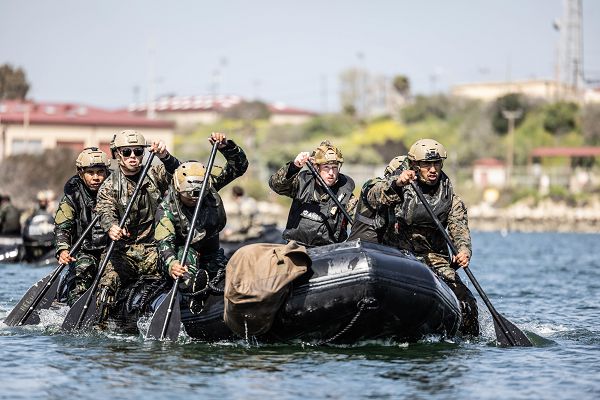
Camp Pendleton, California. (April 15, 2023): In this photo by Corporal Cameron Hermanet, U.S. Marines with 2nd Platoon, Charlie Company, 1st Reconnaissance Battalion, 1st Marine Division and members of the 2nd Intai Amfibi Battalion of the Indonesian Korps Marinir paddle back to shore on a combat rubber craft during a recon exercise at Camp Pendleton. The Marines host this annual exercise to foster greater cooperation and mutual respect between American and Indonesian forces and to share cultural experiences. Just as the Marines are America’s best, these elite reconnaissance troops represent the cream of the armed forces of Indonesia.
Nicknamed the "Sea Ghosts" due to their deadly capabilities as seaborne infantry, the Amfibi have skills far above the average ordinary soldier. When the Indonesian Marine Corps was established in 1961, the nation had no naval reconnaissance capability and saw a clear need for a special force trained in special activities that cannot be done by ordinary units. Indonesia established its own Amphibious Reconnaissance Commando Unit to combine airborne and amphibious skills into one capable force.
- Details
- Hits: 1021
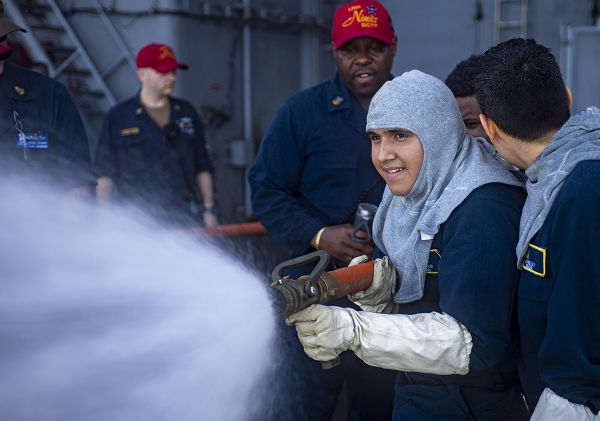
“Life aboard a warship is filled with hazards unique to the Navy.”
Philippine Sea. (May 4, 2023): So long as there are sailors at sea, there will always be a need for a few brave souls willing to risk their lives to do damage control in an emergency. In this photo by MC2 Caitlin Flynn, Sailors operate a firehose during a damage control training exercise aboard the aircraft carrier USS Nimitz while under routine operations. These sailors confront the inherent dangers of working aboard warships, from explosives to biological hazards, which often puts them in harm’s way.
The Damage Control specialist must know how to respond quickly to explosions, fires, and chemical, biological, and radiological threats. Sailors are trained in first aid, fire suppression techniques, and emergency equipment repair. After Basic Training, Damage Controlmen attend the Basic Engineering Common Core course at Great Lakes, Illinois where they study firefighting, shipboard damage control, ventilation systems, and emergency breathing systems.
Upon graduation, Damage Controlmen can expect to be stationed on nearly every type of vessel operating anywhere in the world. As the first responders for the fleet, Damage Controlmen operate around the clock to keep their fellow Sailors safe.
- Details
- Hits: 1375
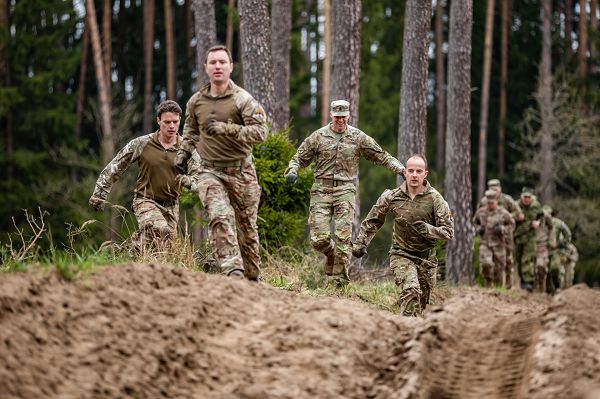
Bemowo Piskie, Poland. (April 15, 2023): In this photo by Staff Sgt. Matthew Foster, U.S. Soldiers assigned to the 2nd Armored Brigade Combat Team,1st Cavalry Division
run the ammunition transfer under fire portion of the multinational Exercise Spur Ride.
The Americans were joined by English, Croatian, and Romanian soldiers in the annual event that is a tradition among the U.S. Cavalry. The Spur Ride is designed to test a cavalry trooper’s physical strength and mental toughness through a series of realistic combat situations. The Spur Ride traces its roots to the early U.S. Cavalry where the new recruits were assigned horses with a shaved tail, indicating their status as rookies. Like their modern-day counterparts, today’s troopers must “Earn their spurs” by showing they are capable of completing tasks necessary to being a cavalryman.
The exercise consists of a series of demanding physical and mental competitions including calling for firemissions, medical evacuations, working in a chemical hazard environment, and reacting to contact with the enemy. Successful graduates are presented their silver spurs and are indoctrinated into the Order of the Spur, a lifetime membership in this honorable tradition.
The 1st Cavalry is supporting the 4th Infantry Division assigned to Europe to conduct multinational training exercises across the continent with our NATO allies.
- Details
- Hits: 1128
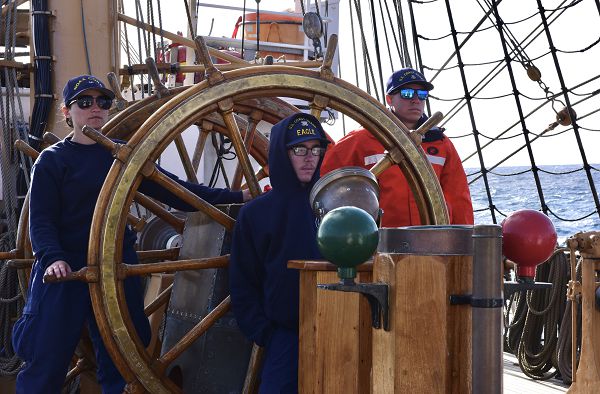
“They that go down to the sea in ships, and occupy their business in great waters;”
Psalm 107, King David.
Atlantic Ocean. (April 16, 2023): American sailors take a step back in history to the days of tall ships driven by the winds and at the mercy of the surf when they board the Eagle, a U.S. Coast Guard sailing ship used to train new officers. In this photo by Petty Officer 2nd Class Brandon Hillard, Officer Candidate Elle Parks, National Ocean and Aeronautics Administration Corps and Coast Guard Seaman Jake Miller , center, a crew member assigned to the Eagle helm the bridge while underway in the Atlantic Ocean. Eagle conducted a four-month summer deployment to teach practical seamanship skills to the future leaders of the U.S. Coast Guard and NOAA Corps, foreign military personnel, and partner members from Tall Ships America.
America has been training its naval officers this way since 1877 when the first cadets enrolled in the U.S. Revenue Cutter Service, the forerunner to today’s Coast Guard. This 295-foot multi-mast cutter is one of only two active commissioned sailing vessels in the United States military today, along with USS Constitution which is ported in Boston Harbor. The Eagle’s mission is to prepare future officers for command through intense courses including navigation, seamanship, ship and boat maneuvering, line handling, sailing, first aid, weather patterns, damage control, and engineering.
- Details
- Hits: 1197
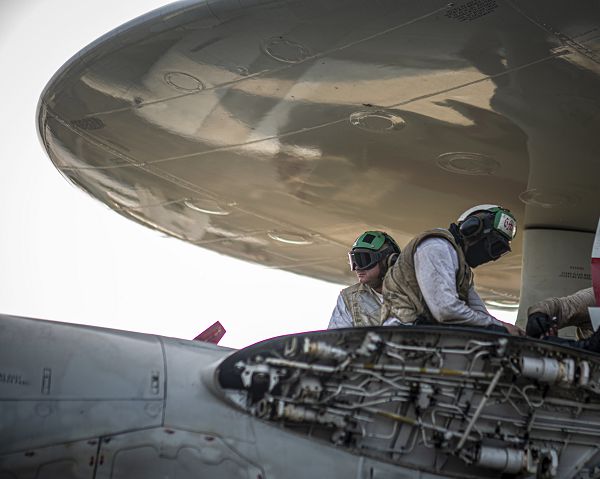
South China Sea. (April 17, 2023): In this photo by MC3 Hannah Kantner, Sailors perform maintenance on an E-2C Hawkeye from the “Sun Kings” of Carrier Airborne Early Warning Squadron 116 on the flight deck aboard the aircraft carrier USS Nimitz. This legendary squadron has served as the “eyes in the skies” for fleet commanders since the Viet Nam War. Established in 1967, the “Sun Kings” provide command and control of the skies to aircraft carrier strike groups and are stationed at Point Mugu, California.
Manufactured by Northrop-Grumman, the E-2 Hawkeye is a two engine propellor driven aircraft that is distinctive for its 24-foot diameter rotating dome mounted above the fuselage. As with all carrier-borne airplanes, the E-2 is equipped with a tail hook for recovery (landing) and the nose gear can attach to the aircraft carrier's catapults for launch (takeoff). This E-2 is also unique because it is the only carrier-borne aircraft to employ primary antennas for its long range radar and IFF systems. The Hawkeye, like virtually all seaborne aircraft, has folding wings to preserve space.
The aircraft is operated by a crew of five, with the pilot and co-pilot on the flight deck and the combat information center officer, air control officer and radar operator stations located in the rear fuselage directly beneath the rotodome. The E-2 Hawkeye is a crucial component of all U.S. Navy carrier air wings. They run a continuous 24-hour-a-day operation of at least one E-2 in the air and for one or two undergoing maintenance in the aircraft carrier's hangar deck at all times.
The Hawkeye performs a number of vital missions for the fleet including sea and land surveillance, control of the aircraft carrier's fighter planes for air defense, managing strike aircraft on offensive missions, and the directing search and rescue missions for naval aviators or sailors lost at sea. It can also serve in an air traffic control capacity in emergency situations.
Using its advanced electronic sensors combined with digital computer signal processing, the Hawkeye gives commanders real time warning of approaching enemy aircraft and anti-ship missile attacks while controlling the carrier's combat air patrol fighters as they protect the fleet.


